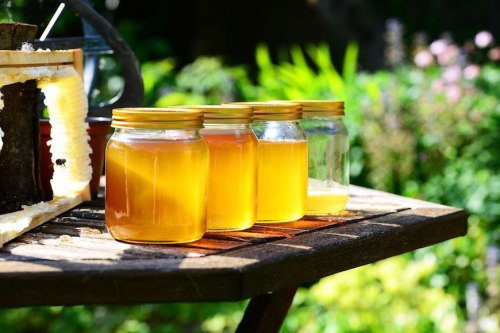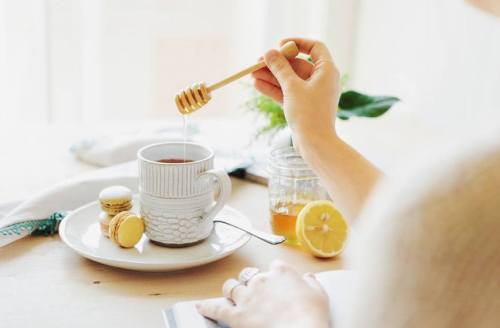Our editors independently select these products. Making a purchase through our links may earn Well+Good a commission
I consider myself a pretty savvy healthy food shopper; I scour the grocery store shelves armed with my mental check-list: Are these eggs ethically sourced? How sustainable is this alt-milk? But to be honest, I never really gave honey much thought. I just figured it was all pretty much the same, so I might as well pick the cheapest one. (Plus, those plastic bears are so cute.)
A bike ride to Growing Gardens, a community garden and bee farm in Boulder, Colorado, changed all that.
“One in three bites of food is impacted by pollinators” like bees, says Alyssa Harding, corporate responsibility manager for Justin’s, which is partnering with Growing Gardens to raise awareness of the fact that bees are in trouble. Like, serious trouble: According to Justin’s, honey bees are dying off at a rate of 44 percent for year, and that poses a looming threat to our entire food system.
How can you—and I (you know, non-beekeeping folk)—make a difference? As I learned at Growing Gardens, you can start by being mindful about the honey you’re purchasing.
Here’s what you need to know before stocking up on the sweet stuff.

First, a quick eco lesson on how honey is made: Bees flit from flower to flower, collecting nectar and pollen as they go and storing it in a second stomach reserved for just that purpose. When they’re full-up, they head back to the hive, where they pass the nectar on to worker bees by regurgitating the liquid into their proboscises, or pointy beaks. (Cool! Gross!) The worker bees chew on the mixture for a bit before having their turn at regurgitation, spreading the now-liquified nectar into honeycomb compartments. The bees’ steady wing flapping causes just enough evaporation to give the watery substance that signature honey stickiness. Because the nectar can essentially come from any flowering plant, there are nearly endless honey varieties. Lavender honey, rosemary honey, dandelion honey….
“Every type of honey has nutritional benefits,” says registered dietitian Kelly Springer. “All honey has proteins and enzymes that are antibacterial and can help heal the gut lining, allergies, and even acne, if it’s applied topically.” It’s also high in antioxidants, which can lower the risk for infection and disease and helps to stabilize free radicals in the body.
Manuka honey, meanwhile, is like regular honey on steroids. Springer says it has all the aforementioned benefits, but is much more potent. Many people use it medicinally, to prevent or treat digestive problems, allergies, or bacterial infections (though it’s safe to consume every day). Because of the super benefits, she says it’s worth the splurge. (Her fave brand is Wedderspoon Raw Premium Manuka Honey, $33.)
“Even if the front of the label says it’s pure honey, you want to read the back of the label and make sure the ingredients only says ‘honey.'” —Carla Marina Marchese, founder of the American Honey Tasting Society
According to Carla Marina Marchese, founder of the American Honey Tasting Society and co-author of The Honey Connoisseur, other than manuka honey, there isn’t much nutritional difference between all the different types of honey out there, but you will notice a difference in the taste. “Just like wine and olive oil, honey has different notes,” she says. “Some are bitter, some sweet, and some floral.” Marchese hosts honey tastings on the reg and she says without a doubt, you can tell the difference between a commercially purchased honey and a local one.
“Pure honey has complexities in the taste that you won’t find in commercial honey because it’s not processed,” she says. It’s more nutrient-dense, too: Commercial honey is often cut with other ingredients, including synthetic sweeteners. “If you’re buying honey at the grocery store, even if the front of the label says it’s pure honey, you want to read the back of the label and make sure the ingredients only says ‘honey,'” she says. She also adds that many big commercial brands heat their honey, which kills some of the healthy enzymes.
Another tip: Go for honey in glass jars, not plastic. “Honey is very fragile and not as stable in plastic,” Marchese says. “If you’re buying local honey and it’s in a plastic container, I would consume it within one year. After that, you’ll start to see changes in color and taste.” While the color can range from dark, almost-black to a very light or even orange hue—all of which are fine—good-quality honey is a little bit foggy from the pollen.
The easiest way to ensure you’re buying the best product, according to Marchese, is to find it at your farmer’s market rather than a big-box grocery store. Not only are you the most likely to be getting pure honey, she says, but you can ask the beekeepers about their use of pesticides, which unfortunately have made their way into most honeys on the market, and chat about their sourcing. And if my trip to Boulder was any indication, the passion they have for their work will have you buzzing about honey—and the bees—long after.
While you’re giving your grocery shopping habits some thought, check out these mistakes even healthy eaters make at the store. And here’s your complete guide to buying greens.
Sign Up for Our Daily Newsletter
Get all the latest in wellness, trends, food, fitness, beauty, and more delivered right to your inbox.
Got it, you've been added to our email list.











